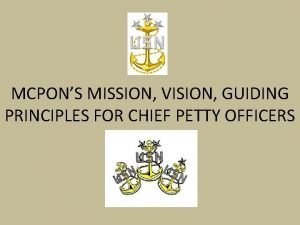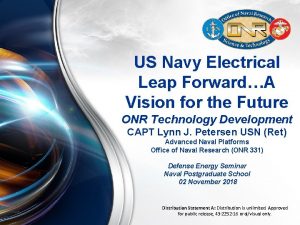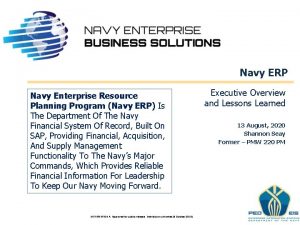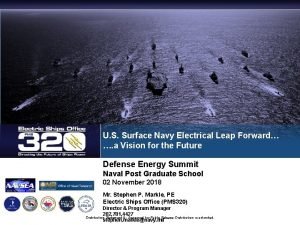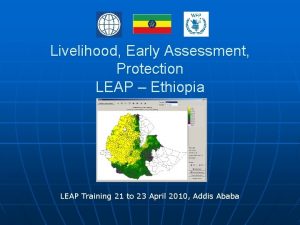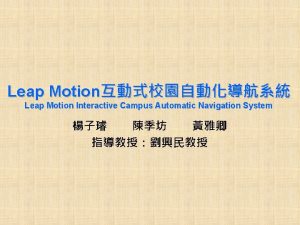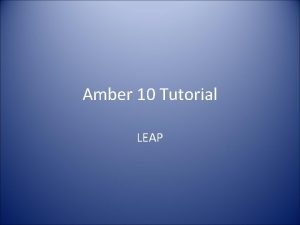US Navy Electrical Leap ForwardA Vision for the















- Slides: 15

US Navy Electrical Leap Forward…A Vision for the Future ONR Technology Development CAPT Lynn J. Petersen USN (Ret) Advanced Naval Platforms Office of Naval Research (ONR 331) Defense Energy Seminar Naval Postgraduate School 02 November 2018 Distribution Statement A: Distribution is unlimited. Approved for public release, 43 -2252 -16 oral/visual only.

ONR Technology Development Overview ONR Naval Research & Development Framework Power Electronics & Electromagnetism (6. 1) Adaptive Controls (6. 1) Machinery Controls (6. 2) Advanced Machinery Systems (6. 2) Ø Medium Voltage Direct Current (MVDC) Risk Reduction Ø Applied Silicon Carbide (Si. C) Technology Future Naval Capabilities (6. 2 -6. 4) Distribution Statement A: Distribution is unlimited. Approved for public release, 43 -2252 -16 oral/visual only. 2

A Guiding Vision ALIGN ACCELERATE To Shared R&D Priorities Technology-Enabled Capabilities ALLOCATE Resources to Speed Results To Win We Must Be “First to Field Decisive Capabilities”

It Begins With Research 6. 1 Basic Research 27% 10% Academia 63% 6. 2 Applied Research Industry 31% Framework Priorities • • • 23% Scalable Lethality Augmented Warfighter Operational Endurance Sensing & Sense-Making Integrated & Distributed Forces Distribution Statement A: Distribution is unlimited. Approved for public release, 43 -2252 -16 oral/visual only. Gov’t 46% 6. 3 Advanced Technology Development 21% 20% 59% Accelerating Knowledge to Technology to Capability

Naval Research: A Framework for Accelerating to the Navy & Marine Corps After Next Framework Priorities – Linking Research to Future Force Attributes Framework Priority Description Augmented Warfighter Enhance date to decision-making speed by incorporating cognitive augmentation & autonomous processing & more efficient human-machine interfaces. Operational Endurance Enables maneuverability, energy efficiency, sustained operations & resiliency for warfighters and platforms, including cyber, regardless of the threat & forward operating environments. Integrated & Distributed Forces Enhances dynamic synchronized actions & interoperability for naval forces. Supports collaboration spanning geography, domains, platforms & joint partners. Incorporates autonomous & disaggregate systems into the naval forces to increase flexibility & reach. Sensing & Sense-Making Drowning in data, yet thirsting fro knowledge, this priority assures awareness of the operating environment & mitigates risk of operational surprise; enables our naval force to operate in concert with the operational environment rather than despite it. Scalable Lethality Enables multi-domain, integrated, scalable kinetic & non-kinetic weapon systems for offensive or defensive purposes. Distribution A; Approved for public release, Distribution Unlimited; DCN# 43 -3903 -18. 5

Future Power Demand MORE POWER DIFFERENT DEMAND STEP CHANGE INCREMENTAL DEVELOPMENT OF POWER GENERATION VS. INCREASE IN POWER REQUIREMENT OVER TIME NEW CAPABILITIES DEMAND PULSE AND STOCHASTIC POWER Exponential Capabilities Growth Power Sensor Demand Weapon Demand EW Demand Incremental Flight Upgrades Available Power: Constant Sensor Demand Mission Power Demand: Stochastic Today Power Generation Power Available Power Requirement Power Demand CURRENT AVAILABLE POWER ABOARD SHIPS CANNOT SUPPORT DYNAMIC LOADS Increased Warfighting Capability to Overmatch the Threat Demands Power

Risk Reduction Path to Integrated Power & Energy System (IPES) ONR S&T Compact Power Conversion Advanced Circuit Protection Multifunction Energy Storage Robust Combat Power Control Component Development & Modeling Reduced Scale Hardware In the Loop Demonstrations IPES Advanced Development Model NSWC Land Based Test Sites (LBTS) IPES Distribution A; Approved for public release, Distribution Unlimited; DCN# 43 -3903 -18. 7

6. 1 Program Overview (Power Electronic Devices and Electromagnetism) Objectives / Goals • Fulfill the power and energy needs of the Navy’s nextgeneration weapons and platforms by improving – – Education Reliability of power electronic devices Power density of power systems Manufacturing costs Technical Approach • • Revive and Enhance Education - Prepare next generation of electrical engineers Investigate failure modes of Wide Bandgap (WBG) semiconductors to enable reliable devices Innovative energy extraction Advance electromagnetics technologies to enhance capabilities, efficiency, size, weight, power density, reliability, and cost Naval Relevance / Impact • Navy and Marine Corps require power systems that meet agility, • Recent Accomplishments • Univ of California Davis (Srabonti) FY 18 New Start 20 k. V, 200 A (New) Grants/Contracts • • • Education: (Power Engineering Curriculum: Focus: WBG technology, Common/Differential Mode (CM/DM), EMI); MSEE Power Engineering Program: Texas Tech Univ (TTU) Power Electronics Devices: Gallium Nitride (Ga. N) vertical device growth and substrate development. (UC Davis, UI Urbana Champaign, Penn State NPS, and USNA) Electromagnetics: Machinery Insulation Development and Modeling; (UCONN, OSU, UT Austin) efficiency, scalability, controllability, and security requirements Reliability of pulsed and continuous duty high power & energy Navy & USMC weapon systems • • Gallium Nitride (Ga. N) epitaxial growth development and characterization science. Univ of IL (Hubler) demonstrated experimentally micro capacitor energy density in vacuum gaps exceeding energy density of Li-ion batteries (transferring to Dr. Scott Coombe) Univ of CT (Cao) nano-insulation development improved ac dielectric strength by 50% and thermal conductivity by a factor of 7 (Insulation Workshop: 22 -23 August, 2018; ONR) UT Dallas (Akin) WBG stress testing revealed prominent gate-oxide related failure mechanisms Naval Postgraduate School (Weatherford) (w/SANDIA, UC Berkeley, Penn State University) Ga. N Schottky Diodes 8

Education Objective / Goal • • • Revive and Enhance Education - Prepare next generation of Navy electrical & power engineers Meet increasing demands in power-related fields in the Navy and elsewhere Educate naval officers/civilians to maintain, operate, & sustain naval power systems Summary of Effort • • Develop 19 courses in Electric Power & Energy Systems Disseminate widely by offering course materials free online to all U. S. universities for classroom and distance learning Major Participants • • • Ned Mohan – University of Minnesota; Rob Cuzner. University of Milwaukee; Andy Lemmon/Aaron Brovont. University of Alabama; and Anant Agarwal-The Ohio State University Consortium of Universities for Sustainable Power (CUSP) – 235 universities participating as of April 2018 Supporting Catholic University Power Engineering Curriculum Development Power Engineering Curriculum for our Naval Officers and Civilian Workforce is a Critical National Interest!! Recent Accomplishments • 15 courses completed • 4 courses not yet started; grants initiated • Adopted by USNA and Naval Postgraduate School for core and distance learning curriculum • Over 100 universities are using these materials Key Milestones / Projected Transition • Near: Publication of all 15 courses in FY 18; 4 more by FY 21 • Mid/Far: Educate/Train Navy Electrical Engineering Workforce with emerging technologies (COMNAVSEA 05 Z and NSWC PD technical work force benefiting now!); MSEE Power Engineering Degree Program initiated in FY 18 (available FY 19) 9

6. 1 Adaptive Controls Objective / Goal • • Provide a leap ahead capability for Do. D platforms that utilize Distributed Machinery Systems (resources to loads) by implementing advanced resilient control architectures that operate from a ‘Systems of Systems’ perspective. Focuses on “Getting the human out of the loop” Technical Summary of Research • Hybrid diagnostic algorithms for higher order nonlinear systems: Chandrasekhar Nataraj (Villanova) Ending FY 19 • Microgrid modeling and control with multiple distributed energy sources: Wenxin Liu (Lehigh) (transition to RCP FNC) • Correct by construction autonomy protocols for open, reconfigurable shipboard networks: Ufuk Topku (UT Austin) • Adaptive Controls for Navy microgrid circuits: Henry Yeh (CSU Long Beach) Ending FY 18 • High-speed, scalable, system-level real-time simulation: Andrea Begnini (U of So Carolina) • Distributed verification and validation methods for power system dynamics and control: Kurtis Kredo (CSU Chico) Ending FY 18; new FY 19 effort planned. • Mixed Initiative, Cooperative Self-Adaption for System of Systems: David Garlan (Carnegie Melon) Ending FY 18 Recent Accomplishments • Lehigh (Liu) submitted 5 related transaction papers • UT Austin (Topku) developed a new multi-objective verification method for parametric Markov decision processes • Villanova (Nataraj) developed a novel “Extended Phase Space Topology” method and successfully applied to bearing/gear-train diagnosis • U of So. Carolina (Begnini) achieved 40 ns time step for system with 17 converters Key Milestones / Projected Transition • Near: Semi-Annual Controls Workshops in FY 15 -18 (Government, Industry and Academia) • Far: Feeds into: 6. 2 Machinery Controls; Navy Combat Power and Energy System (CPES); Ux. V 10 considerations

6. 2 Machinery Controls Objective / Goal Enable the implementation of Autonomous Cognitive Capabilities for next generation naval ship machinery systems. To enable understanding, design, operation and affordability of increasingly complex, integrated, and interdependent systems Technical Summary of Research • • Observability of Network Controlled Multi-Converter Power Systems: Karen Miu (Drexel) (New Start FY 17) Recent Accomplishments • Distributed Autonomy, Resiliancy, and Optimality in Navy Microgrids: Ali Davoudi (UT Arlington) (New Start FY 17) • JHU/APL (Scheidt) developed resilient fitness criteria for auxiliary systems; centralized auxiliary system planner developed and tested • U of Mich (Sun) developed condition monitoringoriented reduced order thermal model for electric machine • U of So Carolina (Ginn) instantiated soft core processors within FPGAs and communicated between them at a full 10 GBit/sec using the Aurora protocol • Development of Universal Controller Architecture for Si. C Based Power Electronic Building Blocks: Herb Ginn (U of So Carolina) (New Start FY 18) Key Milestones / Projected Transition • Active Diagnosis of Navy Machinery: David Scheidt (JHU/APL) (Ending FY 18) • Integrated Active and Predictive Condition Monitoring for All-Electric Drivetrain Systems: Jing Sun (U of Mich) (Next Controls Workshop: Ann Arbor, September, 2018) • Exergy Control: Gordon Parker (Michigan Tech ) • Near: Case study setups and initial algorithm evaluation by FY 18 supporting Robust Combat Power and Control FNC; • Far: Transition to Navy Combat Power and Energy 11 System (CPES);

6. 2 Advanced Machinery Systems Program Overview (MVDC Risk Reduction and Applied Si. C Technology) Objectives / Goals • Fulfill the power and energy needs of the Navy’s nextgeneration weapons and platforms by improving – Reliability of power electronic devices – Power density of power systems – Risk reduction for future application of MVDC Systems Technical Approach Naval Relevance / Impact • Develop, mature and demonstrate devices, components, and systems architectures to enable low risk, power dense MVDC application for future warships • Investigate performance of Wide Bandgap (WBG) Silicon Carbide semiconductors to enable reliable power converter modules • Reduce logistics; Increase maintainability, commonality of Least Replaceable Unit (LRU) WBG converters • • Navy and Marine Corps require power systems that meet agility, efficiency, scalability, controllability, and security requirements Reliability of pulsed and continuous duty high power & energy Navy & USMC weapon systems Recent Accomplishments • • • GE (Raju) and VA Tech (Boroyevich) Demonstrated PEBB 1000 LRU power density of 6. 5 MW/m 3 ; PEBB model created for S 3 D Wolfspeed (Cree) achieved world record 10 k. V/240 A MOSFET Half Bridge Module @ 100 k. HZ switching frequency FY 18 New Start: NPS, UC Santa Cruz Collaboration (Ph. D Thesis: LCDR Damian Oslebo) Pulse vs Fault Characterization USNA/NPS Internships USNA/NSWC Collaboration 12

ONR Shipboard Power & Energy Roadmap N E A R E 2022 R 2023 M 2024 2025 2026 2027 2009 2010 2011 2012 2013 2014 2015 2016 2017 2018 2019 2020 T 2021 ONR S&T Swampworks CNT Power Cables Swampworks Energy Storage ONR FNC P&E 15 -02 Multifunction Energy Storage OSD Hybrid Energy Storage (HESM) Swampworks Arch Studies ONR FNC P&E 08 -01 Compact Power Conversion Future FNCs OSD Thermally Enabling Architectures for Pulse Power Systems (TEAPPS) ONR pre-FNC P&E 18 -Robust Combat Power Control Adv. Electric Architecture ONR FNC P&E 14 -01 Advanced Circuit Protection Power & Energy S&T (ESRDC, Energy Conversion, Power Electronics, Controls, Thermal) ONR Swampworks ONR FNC OSD Electric Weapon & Sensor Enablers Distribution A; Approved for public release, Distribution Unlimited; DCN# 43 -3903 -18. Basic / Applied Res. 13

ONR Technology Development Summary: ONR Naval Research & Development Framework Power Electronics & Electromagnetism (6. 1) Adaptive Controls (6. 1) Machinery Controls (6. 2) Advanced Machinery Systems (6. 2) Ø Medium Voltage Direct Current (MVDC) Risk Reduction Ø Applied Silicon Carbide (Si. C) Technology Future Naval Capabilities (6. 2 -6. 4) Distribution Statement A: Distribution is unlimited. Approved for public release, 43 -2252 -16 oral/visual only. 14

Staying In Touch www. onr. navy. mil Social Media: www. youtube. com/usnavyresearch www. twitter. com/usnavyresearch www. facebook. com/officeofnavalresearch www. flickr. com/usnavyresearch www. navalstem. navylive. dodlive. mil Distribution Statement A: Distribution is unlimited. Approved www. futureforce. navylive. dodlive. mil for public release, 43 -2252 -16 oral/visual only.
 Mcpon guiding principles 2020
Mcpon guiding principles 2020 Human vision vs computer vision
Human vision vs computer vision Vilken grundregel finns det för tronföljden i sverige?
Vilken grundregel finns det för tronföljden i sverige? Vad är densitet
Vad är densitet Ministerstyre för och nackdelar
Ministerstyre för och nackdelar Jätte råtta
Jätte råtta Tack för att ni lyssnade bild
Tack för att ni lyssnade bild Sju principer för tillitsbaserad styrning
Sju principer för tillitsbaserad styrning Vem räknas som jude
Vem räknas som jude Ro i rom pax
Ro i rom pax Nyckelkompetenser för livslångt lärande
Nyckelkompetenser för livslångt lärande Datumr
Datumr Verksamhetsanalys exempel
Verksamhetsanalys exempel Matematisk modellering eksempel
Matematisk modellering eksempel Shivaiter
Shivaiter Cks
Cks
